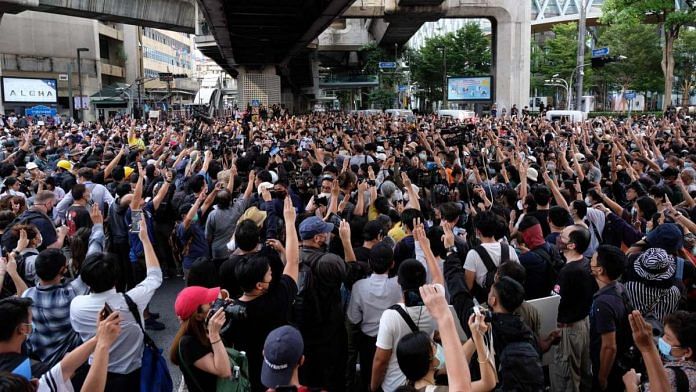New Delhi: Young protesters are taking to the streets of Thailand to express their dismay with the current constitutional framework governing the country. They want the military and the special powers of the monarchy to go, and are demanding fresh elections to bring in a new government.
In episode 600 of Cut the Clutter, ThePrint Editor-in-Chief Shekhar Gupta explained that the underlying cause of these protests is a long-standing collaboration between Thailand’s centuries-old monarchy, the Chakri dynasty, and the military.
Once a democratically elected government comes to power, “their powers are circumscribed quite tightly by the laws and the rules, or even the Constitution, that the military and the monarchy design,” Gupta said.
Elections in Thailand have been routinely punctuated by military coups — much like neighbouring Pakistan. However, despite this political instability, the government doesn’t collapse, and manages to do better than other Asian nations on several development indices.
But the current protests have put the government in a bind, said Gupta, because unlike protests of the past, this one is being led by young people, is more spontaneous, and lacks a clear leadership.
Also read: Thailand braces for more protests after PM Prayuth Chan-Ocha ignores calls to quit
A history of military coups
The first military coup in Thailand took place in 1932, birthing a modern nation state called Siam. Since then, there have been over 20 military coups in Thailand’s history.
The current monarch, Maha Vajiralongkorn, is the tenth in the Chakri dynasty to take the throne. Also known as Rama 10, he took the throne at age 64, shortly after the death of his father, Rama 9, who ruled for 17 years.
Between 1932 and 2020, Thailand has only seen three monarchs — Ramas 8, 9, and 10.
For generations, the monarchy and military have had a “very comfortable, smug arrangement” whereby they share power “by keeping a bonzai elected government every now and then, then firing them and and finding somebody else,” said Gupta.
He drew a timeline of elections and military coups that have occurred so far — all of them bloodless, with the exception of a king who died mysteriously in 1946. The 17th coup since 1932 took place in 1991, and within 10 years, the government changed six times, putting into power Prime Ministers Anand Panyarachun (1992), Chuan Leekpai (1992-1995), Banharn Silpa-archa (1995-1996), Chavalit Yongchaiyudh (1996-1997), Leekpai again (1997 – 2001), before Thaksin Shinawatra was elected in 2001.
Shinawatra was a populist leader who upset the “smug balance” between the military and monarchy, but survived for five years till 2006, before another palace-backed military coup installed an Army Chief General. Shinawatra’s rule was significant, Gupta said, since he was Thailand’s first and last “genuinely popular leader” among the working classes.
After more elections, Shinawatra supporters, all wearing red shirts symbolising the working classes, took to the streets in 2010. They were opposed by the ‘yellow shirts’, the more urban supporters of the status quo.
“This became quite uncomfortable for the powers that be. It is then that force was used against these public demonstrators. The army stormed their processions and 91 people were killed,” Gupta said.
Shinawatra’s younger sister won the 2011 election, but was fired by a constitutional court and later sent to exile in 2014.
Also read: Thai govt likely to get more aggressive to end anti-monarchy protests, but that could backfire
The current protests
In August 2016, the army and monarchy produced a new constitution “that institutionalised the military’s role in national power”.
This was also the year Rama 9, the current monarch’s father, died. When Vajiralongkorn was anointed in 2017, he produced yet another constitution with the military, supposedly allowing a return to democracy — but with a catch.
All the members in the 250-member upper house, called the Senate, were not to be elected but selected by the monarchy and military. The Senate can reject the laws passed by the lower house, and vote for the Prime Minister.
In the 2019 election, the king’s sister Ratana Rajkanya, stood for the post of PM but her brother abolished the party and warned the electorate not to put troublemakers in power. Section 112, which can jail those who speak against the monarchy, is also a looming threat.
“And that is what these protests are about, because protesters are saying that not only did you pass this constitution, but you also rigged the 2019 election,” said Gupta.
The protesters are also demanding the king’s wealth, which amounts to over Rs 2 lakh crore, be split. The government declared a national emergency on 14 October in an attempt to quell the protests, but, “it doesn’t look like these young people are in any mood right now to give in or to go away,” Gupta said.



